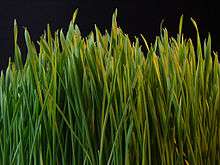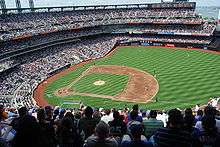Grass


Grasses are monocotyledonous, usually herbaceous flowering plants in the family Poaceae (also called Gramineae). They have stems that are hollow except at the nodes and narrow alternate leaves borne in two ranks. The lower part of each leaf encloses the stem, forming a leaf-sheath. Grasses include cereals, bamboo and the grasses of lawns (turf) and grassland.
Uses for grasses include food (as grain, sprouted grain, shoots, rhizomes and sugar), drink (sugarcane juice, rum, beer, whisky, vodka), pasture for livestock, thatch, paper, fuel, clothing, insulation, timber for fencing, furniture, scaffolding and construction, sports turf, basket weaving and many others.
Ecology

Grasses include some of the most versatile plant life-forms. They became widespread toward the end of the Cretaceous period, and fossilized dinosaur dung (coprolites) have been found containing phytoliths of a variety that include grasses that are related to modern rice and bamboo.[1] Grasses have adapted to conditions in lush rain forests, dry deserts, cold mountains and even intertidal habitats, and are now the most widespread plant type; grass is a valuable source of food and energy for all sorts of wildlife and organics.
Grasses are the dominant vegetation in many habitats, including grassland, salt-marsh, reedswamp and steppes. They also occur as a smaller part of the vegetation in almost every other terrestrial habitat.
Many types of animals eat grass as their main source of food, and are called graminivores – these include cattle, sheep, horses, rabbits and many invertebrates, such as grasshoppers and the caterpillars of many brown butterflies. Grasses are also eaten by omnivorous or even occasionally by primarily carnivorous animals. Grasses are unusual in that the meristem is located near the bottom of the plant, hence can quickly recover from cropping at the top.[2]
In the study of ecological communities, herbaceous plants are divided into graminoids (including grasses) and forbs, which are herbaceous dicotyledons, mostly with broad leaves.
Agriculture
Grasses have always been important to humans. They have been grown as food for domesticated animals for up to 6,000 years. They have been used for paper-making since 2400 BC or before. The most important food crops are the grains of grasses such as wheat, rice, maize (corn) and barley. They have many other uses, such as feeding animals, and for lawns. There are many minor uses, and grasses are familiar to most human cultures.

Lawns

In some places, particularly in suburban areas, the maintenance of a grass lawn is a sign of a homeowner's responsibility to the overall appearance of their neighborhood. One work credits lawn maintenance to:
...the desire for upward mobility and its manifestation in the lawn. As Virginia Jenkins, author of The Lawn, put it quite bluntly, 'Upper middle-class Americans emulated aristocratic society with their own small, semi-rural estates.' In general, the lawn was one of the primary selling points of these new suburban homes, as it shifted social class designations from the equity and ubiquity of urban homes connected to the streets with the upper-middle class designation of a "healthy" green space and the status symbol that is the front lawn.[3][4]
Many municipalities and homeowners' associations have rules which require lawns to be maintained to certain specifications, sanctioning those who allow the grass to grow too long. In communities with drought problems, watering of lawns may be restricted to certain times of day or days of the week.[5]
The smell of the freshly cut grass is produced mainly by cis-3-Hexenal.[6]
Sports turf

Grass is important in many sports, notably with those played on fields such as American football, Association football, baseball, cricket, and rugby. In some sports facilities, including indoor domes and other places where maintenance of a grass field would be difficult, grass may be replaced with artificial turf, a synthetic grass-like substitute. Sports such as golf, tennis and cricket are particularly dependent on the quality of the grass on which the sport is played.
Cricket

In cricket, the pitch is the strip of carefully mowed and rolled grass where the bowler bowls. In the days leading up to the match it is repeatedly mowed and rolled to produce a very hard, flat surface for the ball to bounce off. The quality of the preparation can have a considerable influence on the game; a relatively grassy pitch will favor bowlers and a hard and dryer pitch, with less grass remaining, will typically favor batsmen (at least initially). As the grass dries out and is damaged over the course of the match the pitch's characteristics will change, resulting in batting on the first day of a test match being vastly different from batting on the same pitch after several days of play.
Golf
Golf is very dependent on a quality grass surface. Grass on golf courses is kept in three distinct conditions: that of the rough, the fairway, and the putting green. Grass on the fairway is short and even, allowing the player to cleanly strike the ball. Playing from the rough is a disadvantage because the grass is generally much longer, which may affect the flight of the ball. Grass on the putting green is the shortest and most even, ideally allowing the ball to roll smoothly over the surface. An entire industry revolves around the development and marketing of grasses for golf courses.
Tennis
In tennis, grass is grown on very hard-packed soil, and the bounce of a tennis-ball may vary depending on the grass's health, how recently it has been mowed, and the wear and tear of recent play. The surface is softer than hard courts and clay (other tennis surfaces), so the ball bounces lower, and players must reach the ball faster resulting in a different style of play which may suit some players more than others. The most famous grass tennis court in the world is Centre Court at Wimbledon located in England, home of the Wimbledon Championship.
Literature
- In John Christopher's The Death of Grass (1956, published in the United States as No Blade of Grass), a plague that kills off all forms of grass threatens the survival of the human species.
- In Ward Moore's novel Greener Than You Think, the world is slowly taken over by unstoppable Bermuda Grass.
- Alice Munro's story "Save the Reaper" (1998) contains an important allusion to the idiomatic saying, "To hear the grass grow"; the aging protagonist remembers her grandfather's telling her when she was young that "at night you could hear the corn growing" in the region where the story is set.[7] The protagonist hears the grass grow in ways that are central to the story's significance on the topic of retelling, or rather, in an act of self-censorship, of leaving untold certain experiences of the recent past.[8]
- The title of Walt Whitman's poetry collection Leaves of Grass (1855) contains two puns: "leaves", referring to the pages on which the book was written, and "grass", a term given by publishers to works of minor value.
References
- ↑ Piperno, Dolores R.; Sues, Hans-Dieter (18 November 2005). "Dinosaurs Dined on Grass". Science 310 (5751): 1126–1128. doi:10.1126/science.1121020. PMID 16293745.
- ↑ "Chapter 1: How grasses grow". Farmwest.com. Retrieved 2013-08-26.
- ↑ Matthew J. Lindstrom, Hugh Bartling, Suburban sprawl: culture, theory, and politics (2003), p. 72, quoting Virginia Scott Jenkins, The Lawn: A History of an American Obsession (1994), p.21.
- ↑ Paul Robbins and Julie T. Sharp, "Producing and Consuming Chemicals: The Moral Economy of the American Lawn", Economic Geography 79:4 (2003), p. 425-45; reprinted in William G. Moseley, David A. Lanegran, Kavita Pandit, The Introductory Reader in Human Geography (2007), p. 323-36.
- ↑ "Lawn Sprinkling Regulations in Metro Vancouver, BC, Canada". Metrovancouver.org. 2011-02-21. Retrieved 2013-08-26.
- ↑ "hexenal". School of Chemistry, University of Bristol. Retrieved 2013-08-26.
- ↑ For publication details of "Save the Reaper" by Alice Munro see List of short stories by Alice Munro.
- ↑ Miller, Judith Maclean (Spring 2002). "Deconstructing Silence: The Mystery of Alice Munro". Antigonish Review (129). pp. 43–52.
Further reading
- Chapman, G.P. and W.E. Peat. 1992. An Introduction to the Grasses. CAB Internat., Oxon, UK.
- Cheplick, G.P. 1998. Population Biology of Grasses. Cambridge University Press, Cambridge.
- Milne, L. and M. Milne. 1967. Living Plants of the World. Chaticleer Press, N.Y.
- Soderstrom, T.R., K.W. Hilu, C.S. Campbell, and M.E. Barkworth, eds. 1987. Grass Systematics and Evolution. Smithsonian Institution Press, Washington, D.C.
- Went, Frits W. 1963. The Plants. Time-Life Books, N.Y.
External links
| Wikimedia Commons has media related to Grass. |
 The dictionary definition of grass at Wiktionary
The dictionary definition of grass at Wiktionary- Need a Definition of Grass?
- Vegetative Key to Grasses
|